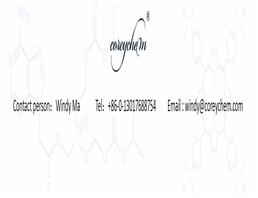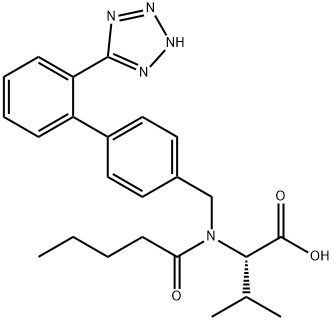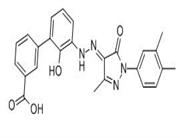| Indications and Usage |
Valsartan is a type of specific angiotensin I (AT1) receptor antagonist and a clinical non-dermal AT1 receptor antagonist following losartan that has important effects in adjusting bodily blood pressure and maintaining electrolyte-body fluid balance. Valsartan’s antihypertensive effects are stronger than those of enalapril and is suitable for treating hypertension, mild to moderate primary hypertension, and especially secondary hypertension caused by renal damage. It can significantly reduce proteinuria for hypertension patients with diabetes or normal liver functions, and it can promote uric acid and urinary sodium to protect the kidney. Valsartan is also suitable for reducing the cardiovascular mortality for high risk patients (left ventricular failure or dysfunction) after experiencing a heart attack. |
| Mechanisms of Action |
Valsartan selectively affects the AT1 receptor subtype and prevents AT1 from binding with AT1 receptors (its selective AT1 receptor antagonizing effect is about 20000 times greater than its effects on AT2 receptors), thus inhibiting vasoconstriction and aldosterone release, producing an antihypertensive effect, but it cannot inhibit the release of aldosterone caused by potassium ions (K+). Valsartan does not affect angiotensin-converting enzymes (ACE) or renin and its receptors, and it does not inhibit ion channels related to blood pressure regulation and sodium balance. Valsartan does not inhibit ACE and does not affect bodily bradykinin levels, thus causing less coughing side effects than ACE inhibitors. Valsartan does not affect heart rate when lowering blood pressure. Sudden ceasing in Valsartan use will not cause rebound hypertension or other side effects. Valsartan does not affect hypertension patients’ overall cholesterol, triglyceride, blood glucose, or uric acid levels. |
| Pharmacokinetics |
For most patients, a single oral dose will have antihypertensive effects that occur within 2 hours, peak at 4-6 hours, and continue for over 24 hours. 2-4 weeks of treatment will result in maximum hypertensive curative effects, which will last throughout long-term treatment. It can be used with thiazide diuretics to further strengthen antihypertensive effects. |
| Clinical Research |
A clinical trial showed that Valsartan has very noticeable effects on mild to moderate hypertension. A daily dose of ≥80 mg can effectively control systolic and diastolic blood pressure while not affecting blood pressure’s circadian rhythm; a daily 160mg dose has more noticeable effects than a daily 100mg dose of losartan. Moderate hypertension patients with intact renal functions have a good tolerance towards Valsartan, Valsartan’s curative effects are significantly superior to those of ACE inhibitors, and there are minimal adverse reactions. Effective in treating severe hypertension when combined with other antihypertensive drugs. |
| Chemical Properties |
White Crystalline Powder |
| Uses |
A nonpeptide angiotensin II AT1-receptor antagonist. Antihypertensive. |
| Uses |
Angiotensin II inhibitor, antihypertensive |
| Uses |
May be used as a first line agent to treat uncomplicated hypertension, isolated systolic hypertension and left ventricular hypertrophy. May be used as a first line agent to delay progression of diabetic nephropathy. Losartan may be also used as a second l |
| Definition |
ChEBI: A monocarboxylic acid amide consisting of L-valine in which the amino hydrogens have been replaced by a pentanoyl and a [2'-(1H-tetrazol-5-yl)biphenyl]-4-yl]methyl group. It exhibits antihypertensive activity. |

 China
China









